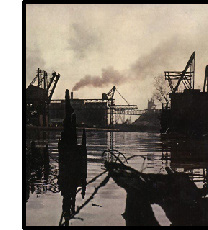
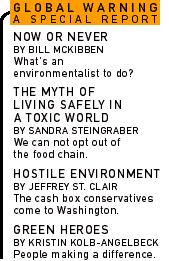
|
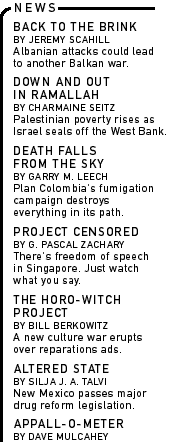
|
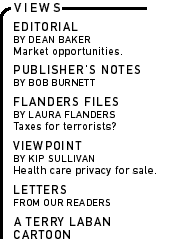
|
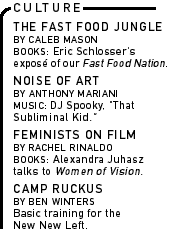
|
| |
|
|
|
In the spring of 1997, after four years of research and writing, I published Living Downstream, a book that explored the relationship between human cancer and environmental contamination. Soon after, I was sent by my publisher on a two-week book tour that lasted a year and a half. It finally ended in September 1998 when I gave my last phone interview while sitting on a towel: I was in labor with my first child, and my water had just broken. I canceled an appearance in Boston that was scheduled for later that evening and headed to the hospital to give birth. Then I went on a self-declared maternity leave. The 18 months I spent on the road with Living Downstream formed an amazing journey. It was an odyssey that took me not only to bookstores, radio studios and the sets of Hollywood talk shows, but to medical schools, college campuses, public libraries, church basements, union meeting halls, the floors of various state legislatures and the headquarters of the Environmental Protection Agency. I met with university presidents, ministers, rabbis, pediatric oncologists, breast cancer activists, government scientists, business leaders and elected officials--but mostly I talked with a lot of plain, ordinary folks. I spoke with mothers of children with brain tumors who lived near Superfund sites; Montana wheat farmers worried that herbicides had something to do with their high rates of lymphoma; student athletes curious about the pesticides used on the fields where they practiced; wealthy retirees wondering about the chemicals sprayed on their beloved golf courses; native women in Alaska who live near old military installations that leak PCBs; and sheep farmers in Ireland who suspected that insecticides were poisoning their drinking water. In all these conversations, public and private, I became impressed with how deeply
I didn't know how to rescue my audiences from their own fatalistic thinking, and its manifestation during our discussions frustrated me. Perhaps because I'm a cancer survivor myself--I was diagnosed with bladder cancer at the age of 20--I view despair as a waste of time. Cancer patients learn to have hope in desperate circumstances, and we don't tend to surrender when the odds are stacked against us. If we could just bring this same damn-the-torpedoes attitude to our political lives, I thought, we would be a powerful force to reckon with. In this, I tend to side with my Canadian friend, the children's singer Raffi, who argues that pessimism--with its smug presumption that solutions to our current predicament do not exist and cannot possibly lie just ahead of us--is a form of arrogance. "No new paradigm has ever sprung from the cynicism of arrested imagination," writes Raffi in his autobiography. But I also began to see that another obstacle was preventing my readers from finding the courage to act on their convictions. I call it the myth of living safely in a toxic world. It works like this. Environmental education in this country tends to focus on individual actions. From Earth Day pamphlets to college environmental science textbooks, we are exhorted to recycle, compost our food scraps, turn off the tap while brushing our teeth, and insulate our attics. If we are interested in protecting our own health against a toxic onslaught, we might be advised, say, to air out our freshly dry-cleaned suits before hanging them in the closet, or give up dry-cleaning altogether. We are not told how we might collectively persuade the dry-cleaning industry to switch over to non-toxic, wet-cleaning technology. (The dry-cleaning solvent perchloroethylene is a suspected carcinogen and a common contaminant of drinking water. In Ithaca, New York, where I live, the headlines this morning announce a final plan for remediating the contaminated soil and groundwater at one local dry-cleaning shop; the problem was first discovered 10 years earlier. Such stories are replicated across the United States.) Or consider the widespread contamination of ocean fish with mercury, which is now widely acknowledged as a threat to public health. The official response of our state and federal governments has been to warn the most vulnerable among us--pregnant and nursing mothers--to restrict their consumption of fish. Meanwhile, the industries responsible for creating the problem--coal-burning power plants, for example--are not warned to restrict their emissions of mercury. (OK, as of January 2001 they have been so warned, but electric utilities will not be forced to do anything about it until 2007, which leaves all of us having babies now with no other choice than to forgo tuna sandwiches in order to protect the brains of our unborn children.) This relentless attention to individual sacrifices seems almost unique to environmental issues. Other human troubles--shootings in schools, intoxicated drivers on the highway, cigarette addiction among teen-agers--are widely understood as political problems requiring political solutions. Thus, a million moms march on Washington to demand changes in handgun regulations, Mothers Against Drunk Drivers pushes for lower legal limits on blood alcohol levels, and tobacco advertising is restricted. We somehow understand that inviting individual citizens to just say no to firearms, liquor and cigarettes isn't the total solution. In contrast, we pretend as if we can all live safely in a toxic world if we as individual consumers just give up enough stuff: stop eating meat, stop eating fish, stop drinking tap water, stop swimming in chlorinated pools, stop microwaving in plastic, swear off dairy products, remove shoes at the door so as not to track lawn chemicals into the living room, handwash silk blouses rather than drop them off at the dry-cleaners. Or worse yet, we pretend we can shop our way out of the environmental crisis: buy air filters, buy water filters, buy bottled water, buy pesticide-removing soaps for our vegetables, buy vitamin pills loaded with anti-oxidants to undo whatever damage we can't avoid. It's as though we all aspire to become the ecological equivalent of the boy in the bubble. No wonder people feel depressed. Fortunately--and I do think it is fortunate--few of these lifestyle sacrifices actually offer much real protection for public health. The reason I think this is good news is that the sooner we quit trying to turn our bodies and homes into fortresses against toxic invasions, the sooner we'll realize that we have no choice but to rise up and demand an end to the invasion. The hard fact is that we cannot opt out of the water cycle or the food chain. Consider drinking water. You might think you can save yourself from exposures to carcinogens in tap water by purchasing bottled water. But the sense of safety offered by bottled water is a mirage. Because the industry is unregulated, there is no telling what's actually in the bottle. It frequently contains trace contaminants. In some cases, it even is tap water. Moreover, it turns out that breathing, not drinking, constitutes our main route of exposure to volatile pollutants in tap water. This is because most of them--solvents, pesticides, by-products of water chlorination--easily evaporate. As soon as the toilet is flushed or the faucet turned on, these contaminants leave the water and enter the air. A recent study shows that the most efficient way of exposing yourself to chemical contaminants in tap water is to turn on a dishwasher. (This surprises you?) Drink a bottle of French water and then step into the shower for 10 minutes, and you've just received the exposure equivalent of a half-gallon of tap water. In short, we are all obligated to protect public drinking water, with which we enjoy the most intimate of relationships whether we want to or not. Well, then, I'll just filter all the tap water coming into my house, you might be thinking here. Think again. Even if these gadgets worked perfectly--and they don't--you are faced with changing them every three to six months. You're left with a spent water filter laden with all the chemical toxics you're determined to keep out of your own body. Now what are you going to do? Throw it in the trash so it can end up leaching in a landfill and contaminating someone else's well? Or become a source of dioxin when it's shoveled into an incinerator and lit on fire? Filters for tap water are nothing more than a way of playing an elaborate shell game with harmful chemicals. Or consider breast milk, that most perfect form of infant nutrition, with its unsurpassed powers to boost IQ, fend off infectious diseases, encourage the development of the immune system, and prevent diabetes, allergies and obesity. Because it exists at the top of the human food chain, mothers' milk has become the most chemically contaminated of all human foods. It carries concentrations of organochlorine pollutants that are 10 to 20 times higher than cows' milk. Indeed, prevailing levels of chemical contaminants in human milk often exceed legally allowable limits in commercial foodstuffs. Thus, on average, in industrialized countries, breast-fed infants ingest each day 50 times more PCBs, per pound of body weight, than do their parents. The same is true for dioxins. We cannot ask newborns to become vegetarians. (Soy-based formula is far inferior to human milk. Even as chemically compromised as human breast milk is, breast-fed babies still end up smarter, healthier, less prone to leukemia and exhibiting superior motor skills when compared to their formula-fed counterparts.) We could encourage their mothers to make such changes in their diet, but it turns out that the lifestyle approach to cleaning up breast milk is not very effective. Unless they are strict vegans, vegetarians have just as much dioxin in their fat tissues--from which breast milk is manufactured--as meat-eaters. And even among those who forswear all animal products, veganism must be long standing--commencing a decade or more before a woman becomes pregnant--to result in meaningful declines in breast milk contamination. A Dutch study has compared macrobiotic mothers--whose protein sources come primarily from grains and legumes--with omnivorous mothers. The milk of macrobiotic mothers contained less PCBs, but their DDT levels were no different. Moreover, the nursing infants of macrobiotic mothers were still ingesting levels of contaminants that were two to eight times higher than the "allowable" daily intake. On the other hand, political action works great to purify breast milk. I am pleased to report that average concentrations of certain key breast milk contaminants--DDT, PCBs and dioxins--have declined dramatically since '70s. This improvement is a direct consequence of bans, tighter regulations, incinerator closings, emission reductions, permit denials, right-to-know laws and tougher environmental enforcement. We nursing mothers owe a great debt to thousands of anonymous citizens from all around the world who worked to stop toxic pollution at its source. The way we repay this debt--and continue the process of detoxification--is to stop distracting ourselves with individual sacrifices and get involved with the political struggle. Start by finding out what toxic chemicals are being released into your home community by visiting www.scorecard.org and entering your zip code in the empty box. Then take a look at some of the 35,000 pages of internal chemical industry documents that formed the basis of Bill Moyer's expose, Trade Secrets, which was recently broadcast on PBS. These are available in the Chemical Industry Archives at www.ewg.org. Sit for awhile with the new knowledge you gain from these two Web
sites and notice what emotions and ideas come up for you. Ask yourself
if we have a human rights problem here. Ask yourself how other human
rights activists you admire once prevailed against formidable opponents--how
women won the right to vote, how abolitionists succeeded in divorcing
our economy from slave labor, how workers won the right to a weekend.
I think you will find depression and cynicism soon yielding to inspiration
and courage. On the faculty of Cornell University, Sandra Steingraber lives in Ithaca, New York, with her husband, Jeff de Castro, and their breast-feeding, two-year-old daughter, Faith. Her new book, Having Faith: An Ecologist's Journey to Motherhood, from which some of this essay is adopted, will be published in October.
|


